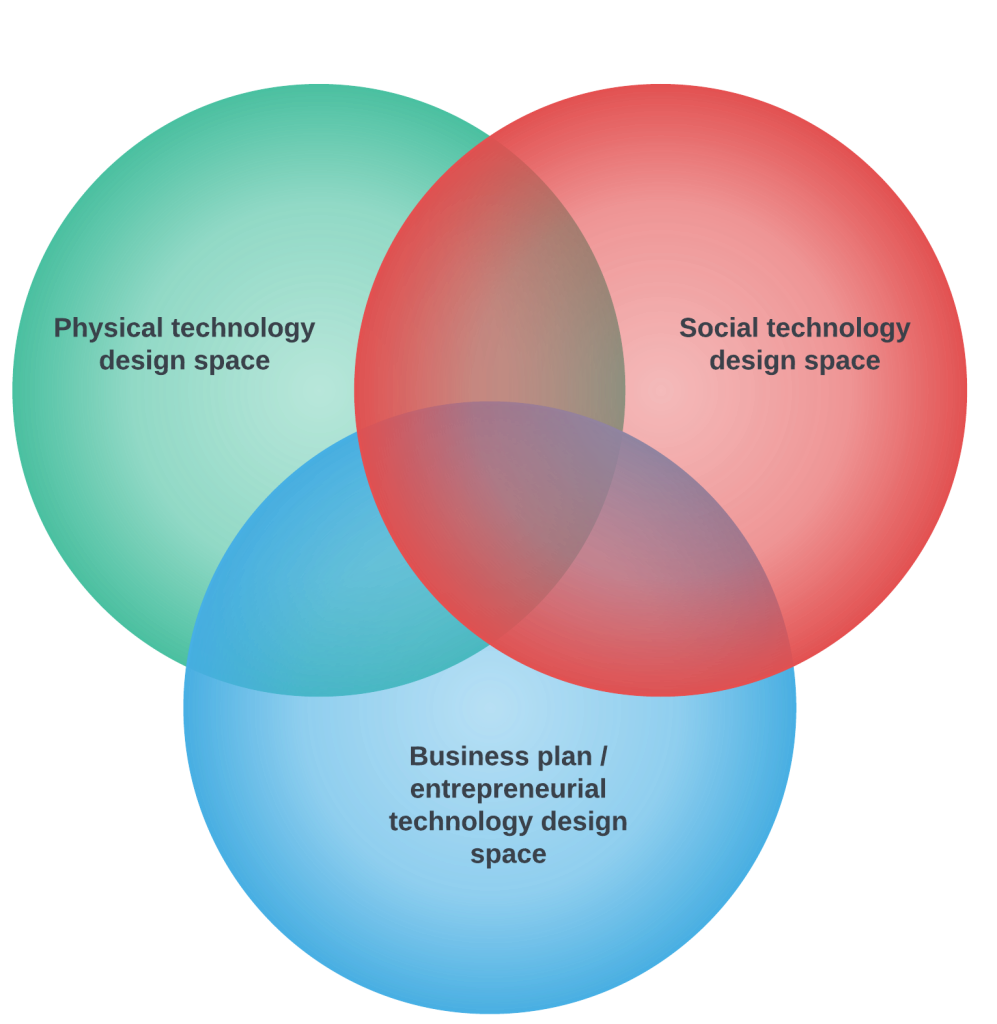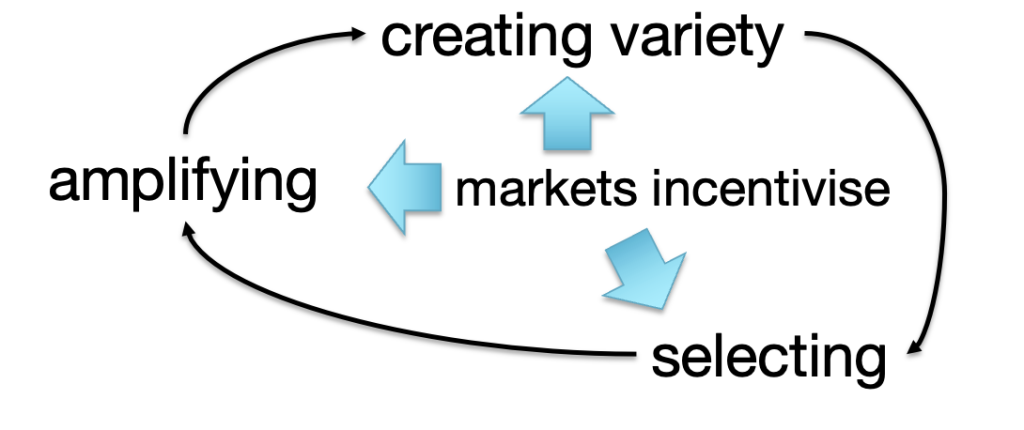Previously, I explained how I circled co-evolution this year. One outcome was the release of how we present Systemic Competitiveness as a cube where all the sides or interdependent.
The second theme interwoven through almost all my consulting and research work this year is also based on another insight from Prof Dave Snowden and the team at Cynefin co (previously known as Cognitive Edge). The theme I have been circling is about about shifting my attention from the lagging indicators of change to the leading indicators of change. My frequent returns to this topic challenged me to shift my focus from what has already happened, to what is possible now in a given context.
This a-ha! was prompted in November 2022 by the content of two black boxes filled with facilitation methods and concepts developed by Cynefin Co. The content of these kits consist of complex methods and practices that can be assembled and reorganised by people as they make sense of their specific context.
What I love about the content of these kits is that many abstract concepts (often explained eloquantly by Dave and friends) are now described on a hexagonal card the size of a beer coaster. People can arrange, pick up, turn over or wave around any of the cards. The front of the card typically contains a short sentence, while the back provides more detail. A small QR code allows people links to a wiki-page with more detailed information. I don’t want include an image of the kit here, but you can take a look by following this link.
Using these kits, my role as the facilitator is to hold the space. I have to encourage people to ponder the cards even if it demands a discussion of an issue that is not-so-obvious or maybe even a little abstract. This is valuable, because in many strategy and reflection workshops people automatically tend to want to talk about the obvious, the topics that everyone agrees are important. The method cards provide structure to guide these conversations without manipulating the discussion based on the bias or preference of the facilitator. When people use these hexi-cards, they have to huddle together around a table. They have to pay careful attention to what others say, or why they place cards in a particular order or place on a map. This is in contrast from the visual facilitation approach I have used for the last twenty years where people sit in a circle or in rows and where all the attention is glued to a facilitator and their visualisation of a topic being explored.
Since I received my Hexi-kits last year, I have not gone to a meeting or a client without some of the Hexi card packs in my bag.
There is one hexi card that stands out to me more than the others. This hexi has challenged my work this year in many different ways, and it is prominently placed on my computer stand to remind me of the following:
“Attitudes are lead indicators, compliance is a lag indicator”.
Dave Snowden, Cynefin Co hexi kit, Attitudinal Mapping hexi
I hope I wont be in trouble for sharing the photo of this hexi below.

With Dave’s permission, I often paraphrase this hexi in conversations about technological change or economic development-related work as follows: “Attitudes are lead indicators, evidence/data is a lag indicator”.
Those that know me would understand why this hexi is so profound to me.
Already, this specific hexi has shaped many of the commissions that I have taken on this year. It also helped me to turn down several projects.
- For instance, it became the refrain in designing a Sensemaker Engagement for an international development project to track emerging signals of change over 12 Eastern European and Western Balkan countries.
- This hexi-card also inspired our Mesopartner 20th anniversary Sensemaker project, where we scanned how economic development practitioners have engaged with and used our Mesopartner instruments over 20 years and how they observed changes unfolding in the development field.
One of the projects that I am leading is the Technological Change and Innovation System Observatory project hosted by TIPS in South Africa. The challenge we face in this project is captured by this same Hexi. Many companies are experimenting with or building their competencies in frontier technologies. The challenge is that these shifts of focus and investment do not yet show up in any reliable datasets (in fact, official data suggests that more investment in the same polices that have not been working are needed). In essence, the interest and focus of our innovators are shifting to capabilities that do not yet exist in domestically. Not only does this reduce the demand or throughput that is needed to make domestic technological competencies viable in the public and the private sectors. It also threatens to drive a bigger gap between those who have (new technology, new knowledge, new opportunities) and those who have not (old technology, conventional knowledge and mature markets) in an already highly unequal country. This hexi gave me the courage to shift from trying to find better data, to paying more attention to subtle changes that signals shifts in behaviour. It demands that we interact with the people that are using new knowledge in different ways, instead of trying to make sense of data. More about this in a later post.
A final remark about the impact of these kits and this particular hexi card on my year. These kits helped me to shift from a strong reliance on developing better diagnostic instruments (what is wrong, or what already happened, as captured by data and evidence) towards an emphasis on what is possible from where we are now, which tensions or contextual nuances can be explored for opportunities to innovate, or how innovations or new capabilities that have gone unnoticed can be amplified (or dampened). Already in this year I have been able to assist my clients to not diagnose that past, but to embrace the possibilities of change offered by the contexts they are immersed in.
***
The hexi-kits published by Cynefin co have really inspired my thinking. Cynefin co has taken collaborative approach and I am delighted to be part of the community of practitioners that are developing additional method packs.
Cynefin co are currently working on version 2 of their kits and I can hardly wait to see what they contain. For the last year I have been working in different collaborations to refine or create new hexi add on packs:
- In July, we released a prototype of our Systemic Insight search and discovery hexi kit to participants of our Summer Academy held annually in Berlin. The featured image of this post is where we showed the participants how to use the Systemic Insight hexi kit.
- We also released our Systemic Competitiveness cube prototype as part of our complex facilitation kit.
We are currently working on several additional kits that are all in different stages of development. Currently, I am working on:
- A hexi add-on pack focused on the diagnosis and improvement of systems of innovation and learning. This kit draws on innovation system, evolutionary economics and new institutional economics to equip stakeholders to identify opportunities to strengthen the learning and innovation practices in an industry, region or around a set of knowledge domains.
- A hexi add-on pack focused on local economic development (with Christian Schoen) drawing on our Mesopartner experience that will equip local collaborators to assess and identify improvement and innovation opportunities in a local economy.
- A hexi add-on pack to diagnose and improve entrepreneurial innovation ecosystems that will equip innovators and network weavers in the private and the public sector to strengthen the interdependence and connections using an ecosystems approach.
I am also collaborating with others in the Cynefin Co network to develop hexi-packs on knowledge management, trust building and technological change.
Some of these ideas are still in their infancy, while others are already quite far advanced. I will only release the next kit after Cynefin release the next versions of their hexikits in the coming months.
In closing, have you been experimenting with these same methods? Are you getting different results as well, or do you also sense that you should shift from figuring out what happened to what is possible?
Let me know how it is going, perhaps we can exchange ideas going forward.
Disclaimer. I am not an employee of Cynefin co. However, I am a paying member of the Cynefin Co premium membership network. I wrote this post because I believe it is important to celebrate and acknowledge the profound effect that Dave’s ideas and methods have had on my praxis.



















